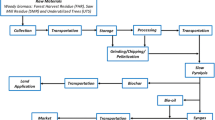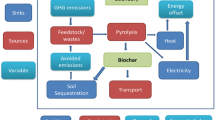Abstract
Biochar-based bioenergy production and subsequent land application of biochar can reduce greenhouse gas emissions by fixing atmospheric carbon into the soil for a long period of time. A thorough life cycle assessment of biochar-based bioenergy production and biochar land application in Northwestern Ontario is conducted using SimaPro® Ver. 8.1. The results of energy consumption and potential environmental impact of biochar-based bioenergy production system are compared with those of conventional coal-based system. Results show that biochar land application consumes 4847.61 MJ per tonne dry feedstock more energy than conventional system, but reduces the GHG emissions by 68.19 kg CO2e per tonne of dry feedstock in its life cycle. Biochar land application improves ecosystem quality by 18 %, reduces climate change by 15 %, and resource use by 13 % but may adversely impact on human health by increasing disability adjusted life years by 1.7 % if biomass availability is low to medium. Replacing fossil fuel with woody biomass has a positive impact on the environment, as one tonne of dry biomass feedstock when converted to biochar reduces up to 38 kg CO2e with biochar land application despite using more energy. These results will help understand a comprehensive picture of the new interventions in forestry businesses, which are promoting biochar-based bioenergy production.


Similar content being viewed by others
References
Afrane G, Ntiamoah A (2011) Comparative life cycle assessment of charcoal, biogas, and liquefied petroleum gas as cooking fuels in Ghana. J Ind Ecol 15:539–549
Alam MB, Pulkki R, Shahi C (2012) Woody biomass availability for bioenergy production using forest depletion spatial data in Northwestern Ontario. Can J For Res 42:506–516
Basso AS, Miguez FE, Laird DA, Horton R, Westgate M (2013) Assessing potential of biochar for increasing water-holding capacity of sandy soils. GCB Bioenergy 5:132–143
Biederman LA, Harpole WS (2013) Biochar and its effects on plant productivity and nutrient cycling: a meta-analysis. GCB Bioenergy 5:202–214
Boateng AA, Mullen CA, Goldberg NM, Hicks KB, Devine TE, Lima IM, McMurtrey JE (2010) Sustainable production of bioenergy and biochar from the straw of high-biomass soybean lines via fast pyrolysis. Environ Prog Sustain Energy 29:175–183
Brown R (2009) Biochar production technology. In: Lehmann J, Joseph S (eds) Biochar for environmental management: science and technology. Routledge, London, pp 127–146
Brownsort P (2009) Biomass pyrolysis processes: performance parameters and their influence on biochar system benefits. M.Sc. Dissertation, University of Edinburgh, Edinburgh
Bruun EW, Ambus P, Egsgaard H, Hauggaard-Nielsen H (2012) Effects of slow and fast pyrolysis biochar on soil C and N turnover dynamics. Soil Biol Biochem 46:73–79
Campbell JE, Lobell DB, Genova RC, Field CB (2008) The global potential of bioenergy on abandoned agriculture lands. Environ Sci Technol 42:5791–5794
Cavalett O, Chagas MF, Seabra JEA, Bonomi A (2013) Comparative LCA of ethanol versus gasoline in Brazil using different LCIA methods. Int J Life Cycle Assess 18:647–658
Department for Environment, Food and Rural Affairs (DEFRA) (2009) Guidance on how to measure and report your greenhouse gas emissions. Department for Environment, Food and Rural Affairs UK. https://www.gov.uk/government/uploads/system/uploads/attachment_data/file/69282/pb13309-ghg-guidance-0909011.pdf. Accessed 10 May 2013
Dutta B, Raghavan V (2014) A life cycle assessment of environmental and economic balance of biochar systems in Quebec. Int J Energy Environ Eng 5:1–11
Dwivedi P, Bailis R, Bush TG, Marinescu M (2011) Quantifying GWI of wood pellet production in the Southern United States and its subsequent utilization for electricity production in the Netherlands/Florida. Bioenergy Res 4:180–192
Elbehri A, Segerstedt A, Liu P (2013) Biofuels and the sustainability challenge: a global assessment of sustainability issues, trends and policies for biofuels and related feedstocks. Food and agriculture organization of the United Nations (FAO), Rome
Elsayed MA, Mortimer ND (2001) Carbon and energy modelling of biomass systems: conversion plant and data updates. DTI http://www.pfpi.net/wp-content/uploads/2011/04/PFPI-biomass-carbon-accounting-overview_April.pdf. Accessed 27 May 2014
Faaij A, Meuleman B, Turkenburg W, van Wijk A, Bauen A, Rosillo-Calle F, Hall D (1998) Externalities of biomass based electricity production compared with power generation from coal in the Netherlands. Biomass Bioenergy 14:125–147
Fantozzi F, Buratti C (2010) Life cycle assessment of biomass chains: wood pellet from short rotation coppice using data measured on a real plant. Biomass Bioenergy 34:1796–1804
Finnveden G, Hauschild MZ, Ekvall T, Guinee J, Heijungs R, Hellweg S, Koehler A, Pennington D, Suh S (2009) Recent developments in life cycle assessment. J Environ Manag 91:1–21
Fowles M (2007) Black carbon sequestration as an alternative to bioenergy. Biomass Bioenergy 31:426–432
Gaunt JL, Lehmann J (2008) Energy balance and emissions associated with biochar sequestration and pyrolysis bioenergy production. Environ Sci Technol 42:4152–4158
Goedkoop M, Spriensma R (2001) The Eco-indicator 99: a damage oriented method for life cycle impact assessment—methodology report. PRe Consultants, Amersfoort
Hammond J, Shackley S, Sohi S, Brownsort P (2011) Prospective life cycle carbon abatement for pyrolysis biochar systems in the UK. Energy Policy 39:2646–2655
Han J, Elgowainy A, Dunn JB, Wang MQ (2013) Life cycle analysis of fuel production from fast pyrolysis of biomass. Bioresour Technol 133:421–428
Homagain K, Shahi C, Luckai N, Sharma M (2014) Biochar-based bioenergy and its environmental impact in northwestern Ontario Canada: a review. J For Res 25(4):737–748
Huang YF, Syu FS, Chiueh PT, Lo SL (2013) Life cycle assessment of biochar cofiring with coal. Bioresour Technol 131:166–171
Humbert S, Schryver AD, Bengoa X, Margni M, Jolliet O (2012) Life cycle assessment IMPACT 2002+ User Guide. http://www.quantis-intl.com/files/8814/1198/3664/IMPACT2002_UserGuide_for_vQ2.21_30April2014a.pdf. Accessed 17 May 2014
Intergovernmental Panel on Climate Change (IPCC) (2007) Climate change 2007: the physical science basis. Contribution of Working Group I to the Fourth Assessment Report of the IPCC. http://www.ipcc.ch/pdf/assessment-report/ar4/wg1/ar4_wg1_full_report.pdf. Accessed 11 Dec 2012
International Biochar Initiative (IBI) (2013) Biochar research and educational resources. http://www.biochar-international.org/research/education. Accessed 10 Dec 2013
International Energy Agency (IEA) (2013) World Energy outlook 2013: executive summary. Paris
Jolliet O, Margni M, Charles RL, Humbert S, Payet J, Rebitzer G, Rosenbaum R (2003) IMPACT 2002+: a new life cycle impact assessment methodology. Int J Life Cycle Assess 8:324–330
Kilpelainen A, Alam A, Strandman H, Kellomaki S (2011) Life cycle assessment tool for estimating net CO2 exchange of forest production. Glob Chang Biol Bioenergy 3:461–471
Kookana RS, Sarmah AK, Van Zwieten L, Krull E, Singh B (2011) Biochar application to soil: agronomic and environmental benefits and unintended consequences. In: Donald LS (ed) Advances in agronomy. Academic Press, San Diego, pp 103–143
Laird DA (2008) The charcoal vision: a win-win-win scenario for simultaneously producing bioenergy, permanently sequestering carbon, while improving soil and water quality. Agron J 100:178–181
Lehmann J (2007) A handful of carbon. Nature 447:143–144
Lehmann J, Joseph S (2009) Biochar for environmental management: an introduction. In: Lehmann J, Joseph S (eds) Biochar for environmental management science and technology. Earthscan, London, Washington D.C., pp 1–12
Lehmann J, Gaunt J, Rondon M (2006) Bio-char sequestration in terrestrial ecosystems: a review. Mitig Adapt Strateg Glob Chang 11:395–419
Magelli F, Boucher K, Bi HT, Melin S, Bonoli A (2009) An environmental impact assessment of exported wood pellets from Canada to Europe. Biomass Bioenergy 33:434–441
Major J (2010) Guidelines on practical aspects of biochar application to field soil in various soil management systems. Int Biochar Initiat, IBI p20
Major J, Lehmann J, Rondon M, Goodale C (2010) Fate of soil-applied black carbon: downward migration, leaching and soil respiration. Glob Chang Biol 16:1366–1379
Ministry of Environment Ontario (MOE) (2010) Ontario’s coal phase out plan 2010. http://news.ontario.ca/mei/en/2009/09/ontarios-coal-phase-out-plan.html. Accessed 13 July 2014
Ministry of Natural Resources (MNR) (2014) Forest resources of Ontario 2011. Ministry of Natural Resources Ontario. https://www.ontario.ca/environment-and-energy/forest-resources-ontario-2011. Accessed 15 July 2014
Mortimer ND, Evans A, Shaw VL, Hunter AJ (2009) Life cycle and techno- economic assessment of the North East biomass to liquids project. North Energy Associates Limited, New York
Ontario Power Generation (OPG) (2012) Atikokan Generating Station bio-mass fuel suppliers announced: meeting the needs of a growing economy in Northwestern Ontario. http://www.opg.com/news/releases/121122Atikokan%20Fuel%20Contracts_FINAL.pdf. Accessed 13 July 2014
Pa A, Bi XTT, Sokhansanj S (2011) A life cycle evaluation of wood pellet gasification for district heating in British Columbia. Bioresour Technol 102:6167–6177
Pa A, Craven JS, Bi XTT, Melin S, Sokhansanj S (2012) Environmental footprints of British Columbia wood pellets from a simplified life cycle analysis. Int J Life Cycle Assess 17:220–231
Papong S, Malakul P (2010) Life-cycle energy and environmental analysis of bioethanol production from cassava in Thailand. Bioresour Technol 101:S112–S118
Rehl T, Mueller J (2011) Life cycle assessment of biogas digestate processing technologies. Resour Conserv Recycl 56:92–104
Roberts KG, Gloy BA, Joseph S, Scott NR, Lehmann J (2010) Life cycle assessment of biochar systems: estimating the energetic, economic, and climate change potential. Environ Sci Technol 44(2):827–833
Ronsse F, Van Hecke S, Dickinson D, Prins W (2013) Production and characterization of slow pyrolysis biochar: influence of feedstock type and pyrolysis conditions. GCB Bioenergy 5:104–115
Scientific Applications International Corporation (SAIC) (2006) Life cycle assessment: principles and practice. 11251 Roger Bacon Drive, Reston, VA 20190 USA, p 14
Sohi SP, Krull E, Lopez-Capel E, Bol R (2010) A review of biochar and its use and function in soil. In: Donald LS (ed) Advances in agronomy. Academic Press, San Deigo, pp 47–82
Spokas KA, Cantrell KB, Novak JM, Archer DW, Ippolito JA, Collins HP, Boateng AA, Lima IM, Lamb MC, McAloon AJ, Lentz RD, Nichols KA (2012) Biochar: a synthesis of its agronomic impact beyond carbon sequestration. J Environ Qual 41:973–989
Statistics Canada (StatsCan) (2012) The energy statistics handbook first quarter 2012 (2012). http://www.statcan.gc.ca/pub/57-601-x/57-601-x2012001-eng.pdf. Accessed 10 Feb 2014
Steele P, Puettmann ME, Penmetsa VK, Cooper JE (2012) Life-cycle assessment of pyrolysis bio-oil production. For Prod J 62:326–334
Stephen JD (2013) The viability of lignocellulosic ethanol production as a business endeavour in Canada. PhD Thesis, Faculty of Forestry, University of British Columbia, Canada. P225+xiv
Van-Loo S, Koppejan J (2008) The handbook of biomass combustion and cofiring. Earthscan, London, Washington, DC, p 442+xii
Wood SM, Layzell DB (2003) A Canadian biomass inventory: feedstocks for a bio-based economy. Canada, BIOCAP Canada Foundation, Queen’s University Ontario
Woolf D, Amonette JE, Street-Perrott FA, Lehmann J, Joseph S (2010) Sustainable biochar to mitigate global climate change. Nat Commun 1:56
Xu R, Ferrante L, Hall K, Briens C, Berruti F (2011) Thermal self-sustainability of biochar production by pyrolysis. J Anal Appl Pyrol 91:55–66
Zhang Y, McKechnie J, Cormier D, Lyng R, Mabee W, Ogino A, MacLean HL (2010) Life cycle emissions and cost of producing electricity from coal, natural gas, and wood pellets in Ontario, Canada. Environ Sci Technol 44:538–544
Acknowledgments
Financial contributions from (1) Natural Sciences and Engineering Research Council of Canada through Industrial Postgraduate Scholarships (NSERC-IPS), (2) Ontario Graduate Scholarship (OGS) and (3) Ontario Power Generation (OPG) for this study is highly acknowledged.
Author information
Authors and Affiliations
Corresponding author
Additional information
Project funding: This work was supported by (1) Natural Sciences and Engineering Research Council of Canada through Industrial Postgraduate Scholarships (NSERC-IPS), (2) Ontario Graduate Scholarship (OGS) and (3) Ontario Power Generation (OPG).
The online version is available at http://www.springerlink.com.
Corresponding editor: Chai Ruihai.
Rights and permissions
About this article
Cite this article
Homagain, K., Shahi, C., Luckai, N. et al. Life cycle environmental impact assessment of biochar-based bioenergy production and utilization in Northwestern Ontario, Canada. J. For. Res. 26, 799–809 (2015). https://doi.org/10.1007/s11676-015-0132-y
Received:
Accepted:
Published:
Issue Date:
DOI: https://doi.org/10.1007/s11676-015-0132-y




